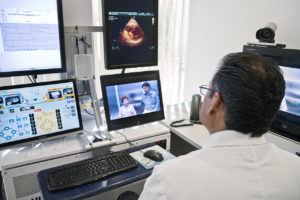FaceTime Meets Healthcare

Supply chain digitization at Kaiser Permanente, one of the nation’s largest health systems promises to bring healthcare to your fingertips.
The California-based health network, Kaiser Permanente had a total of 110 million visits last year, 59 million of which occurred through virtual visits. This marks the first time a large healthcare system has reported more virtual than in-person encounters.1
Digitalization amidst cost and quality concerns
It is well known that healthcare spending in the U.S. outpaces that of other high-income, OECD countries.2 Despite the heavy investment, however, our healthcare outcomes, including life expectancy and chronic disease prevalence trail behind our developed counterparts.
This pressure to reduce costs and improve outcomes coupled with our aging population and the explosion of direct-to-consumer services has left traditional healthcare organizations scrambling to keep pace with an increasingly digitalized society and industry. One strategy that has emerged to cope with the pressures to deliver higher value is telemedicine, defined as the use of electronic information and telecommunications technologies to support and promote long distance clinical health care.
Companies like ZocDoc and Teledoc offer more convenient, lower cost alternatives to traditional visits, which can subject patients to long wait times. While the data on the effect of telemedicine on overall healthcare spending and quality are not clear, patients nonetheless expect the healthcare industry to embrace 21st century technology.3,4
Embracing Telemedicine at Kaiser Permanente
Kaiser Permanente has adopted a 4-pronged approached to incorporating telehealth into the front lines of healthcare delivery. Since investing $10 million in Vidyo, a visual communications company that integrates video into electronic health records, Kaiser Permanente has aggressively expanded its telemedicine options.5
- Teledermatology: A medical assistant trained to obtain high-resolution photos with a digital camera in a primary care physicians’ office can send the picture to a team of rotating dermatologists from across the region. The medical group has found that 70% of skin rashes can be diagnosed and treated from the digital picture alone. These e-consults increase the capacity of specialists to incorporate same-day appointments for patients who require in-person consultation.
- On-site specialty consultations: When a PCP believes a patient would benefit from a specialty consultation, he/she can obtain one via video. More than 40 medical and surgical specialties offer this service. This program reduces delays in diagnosis and treatment and helps to coordinate care among the specialist, patient, and primary care physician.
- Virtual urgent care visits – Patients are connected to emergency physicians by private, secure video. Through virtual visits, 80% of issues can be resolved by phone and 60% of the remaining visits can be resolved by video. An internal survey found that 90% of patients were very or extremely satisfied with the care and advice they received.
- Follow-up and specialist visits – All specialties offer the option of a video visit for follow-up, routine, and urgent medical problems, specialty consultation, surgical follow-up. An internal, password-protect application within a VPN firewall allows physicians to use software application to connect.6
What’s next for Kaiser?
Kaiser Permanente’s adoption of telemedicine is just one component of a broader online platform that is a part of the $400 million investment the organization has made into new and emerging technologies. The online platform is a step toward realizing the organization’s “care anywhere” philosophy.
Kaiser should study the effects of these programs on cost, quality, and patient satisfaction across disease states and populations. By implementing telemedicine on such a broad scale across many different provider types, disease states, geographies, and populations, Kaiser has the ability to contribute substantially to our understanding of the effects of telemedicine.
Kaiser should also transform their telemedicine technologies into proactive rather than reactive tools. Currently, patients engage with online tools only when they are sick. As more payment models move toward accountable care organizations that compensate organizations based on their ability to keep a population of patients healthy, organizations like Kaiser will have to deploy tools to focus on preventative health measures.7
Finally, the suite of online options for patients only work if clinicians choose to engage. Already burdened by long work days and excess paperwork, Kaiser should engage front line clinicians to ensure online tools are not viewed as time consuming or burdensome.8 Physicians in a fee-for-service payment model should be reimbursed adequately and some clinicians may require more support and training on how to engage with online tools.
Beyond the short and long-term adoption of telemedicine, questions still remain:
- How will privacy and data security be addressed in healthcare as providers move toward online visits?
- How will traditional healthcare organizations make decisions about which digital health technologies to invest in and incorporate when the data about their effect on cost and quality is lacking or unclear?
Word count: 791
- Eric WIcklund. Kaiser CEO: Telehealth Outpaced In-Person Visits Last Year. mHealthIntelligence. 2016. https://mhealthintelligence.com/news/kaiser-ceo-telehealth-outpaced-in-person-visits-last-year. Accessed November 13, 2017.
- U.S. Health Care from a Global Perspective. Commonw Fund. 2014;35(1):307-325. http://www.commonwealthfund.org/publications/issue-briefs/2015/oct/us-health-care-from-a-global-perspective. Accessed November 13, 2017.
- Flodgren G, Rachas A, Farmer AJ, Inzitari M, Shepperd S. Interactive telemedicine: effects on professional practice and health care outcomes. In: Shepperd S, ed. Cochrane Database of Systematic Reviews. Chichester, UK: John Wiley & Sons, Ltd; 2015:CD002098. doi:10.1002/14651858.CD002098.pub2.
- Mistry H, Garnvwa H, Oppong R. Critical Appraisal of Published Systematic Reviews Assessing the Cost-Effectiveness of Telemedicine Studies. Telemed e-Health. 2014;20(7):609-618. doi:10.1089/tmj.2013.0259.
- Susan Morse. Kaiser fund invests $10 million into Vidyo telehealth platform | Healthcare IT News. 2015. http://www.healthcareitnews.com/news/kaiser-fund-pumps-10-million-telehealth-platform-vidyo. Accessed November 13, 2017.
- Robert Pearl. Engaging Physicians in Telehealth. NEJM Catal. 2010. https://catalyst.nejm.org/engaging-physicians-in-telehealth/. Accessed November 13, 2017.
- Burwell SM. Setting Value-Based Payment Goals — HHS Efforts to Improve U.S. Health Care. N Engl J Med. 2015;372(10):897-899. doi:10.1056/NEJMp1500445.
- Shanafelt TD, Boone S, Tan L, et al. Burnout and Satisfaction With Work-Life Balance Among US Physicians Relative to the General US Population. Arch Intern Med. 2012;172(18):1377. doi:10.1001/archinternmed.2012.3199.






This is a really important topic in healthcare and your article does a good job of summarizing key points. Your second question around how traditional healthcare organizations will make decisions about digital health technologies is very important. One huge obstacle that healthcare organizations and digital solutions both face is integrating systems and extracting patient information. As more healthcare organizations (e.g. hospitals) adopt Electronic Medical Records (EMR), each system speaks a different language and operates in different ways. As companies try to provide better digital solutions to help improve healthcare, these same innovators face significant integration challenges as they try to connect with different hospitals. While digital solutions are very effective in single systems like Kaiser they can be difficult to implement across a diverse and fragmented U.S. healthcare landscape.
Thank you for such an informative post, @BillNye. I agree with @EL that your article does a good job summarizing the key points, and I thought the discussion about Teledermatology was particularly interesting. As I was reading, I was particularly concerned about what you address in the first of your two questions: “how will privacy and data security be addressed in healthcare as providers move toward online visits?” Given the HIPPA laws and various other constraints placed on medical data, I think this will be one of the most significant challenges in preventing the industry from going more digital. I’m glad that it seems to be working within Kaiser, though I would imagine that patient data and medical records are much easier to share within that more closed-loop context.
Great post and a very thought-provoking discussion. In particular, I thought that your question about decision-making when data is unclear very compelling. One thing that I would like to point out, is that the age of data clarity is relatively new, and many businesses (and hospitals) have had to make many historical significant investment decisions without clear data leading to the right “answer.” In those situations, businesses had to make decisions based on small sample sizes, experts, or what was true to their strategy. In this situation, I imagine that hospitals will make decisions based on three criteria:
1) Clinical concern: While hospitals may not have data yet, it is important to make decisions based upon new initiatives that doctors are demanding, and in specific areas of clinical research that may indicate where medicine will go in the future. Hospitals can also use sample “proxies” to generate data and back up investment decisions.
2) Patient demand: This is a little tenuous, as patients may not know exactly what is the best technology for their own care; however at the end of the day, the hospital’s duty is to provide superior care to the patient and therefore should invest in areas that improve the patient experience (e.g. cater to patient demands).
3) Cost: The cost of the new investment, vs. the capital that the hospital has available, may end up being the deal-breaking information.
Kaiser is a particularly interesting example of how telemedicine can be applied, since it is both a provider and a payer. Since they are on the hook for outcomes as well as treatments, its interesting to see how this can be applied as one piece of holistic care delivery. I think this is a great way to proactively connect with patients which would drastically help with adherence in a minimally invasive way to the patients. I’ll be curious to see how Kaiser continues this program to determine whether it is both a cost saving approach as well as a way to improve outcomes.
Bill Nye, I was curious to read this since I looked into the healthcare supply chain too! Thanks for a clear, focused piece. You bring up an interesting question around privacy and data security. I believe that the existing regulatory frameworks around healthcare data will still apply and can easily cover the use cases you’ve mentioned around telemedicine. The only difference will be that more data will be captured digitally than is being captured today. I think the privacy and data security issues become more tricky when we start to combine the patient outcomes data with other sources of data, such as supply costs data to help providers make better purchasing decisions (check out “Mercy” healthcare systems, providing a few reading links below). On one hand, it is always possible to anonymize and aggregate data, but given low sample sizes and unique features of particular cases, there is a risk to being able to identify patients.
On your question of how traditional healthcare organizations make investment decisions: As mentioned above, I think by combining different sources of data like Mercy is doing, it is possible to measure the effectiveness of these technologies. With two nuances: 1) Healthcare providers should think of ways to “prototype” technologies, or do smaller-scale pilots, so that the costs of learning are reduced, and 2) They have to think about what are the right metrics of “success” carefully, and for whom.
A few other interesting things for us to think about on this topic:
Insurance – As virtual/telemedicine expands, an important party in this equation is those with the purse strings. How will insurers be impacted by this evolution, and how do we engage them to adapt?
The digital supply chain – I’ve read a couple of interesting articles about how this can impact telemedicine; so beyond just providing this virtual medicine, really using a digitized supply chain to measure what’s going on while the patient is home (e.g. for chronic patients) and understanding how their environment affects their condition, or having a supply chain efficient enough to deliver medical goods to the end-patient remotely can be game-changers in this space.
“Healthcare Supply Chainnovators 2016: Global Patient Care and Supply Chain Analytics Win the Day,” Gartner, Inc., accessed November 2017.
World Wide Technology. “Mercy Virtual Creates Anytime Healthcare.” Case study, World Wide Technology website, https://www2.wwt.com/case-study/mercy-virtual-creates-anytime-healthcare/, accessed November 2017.